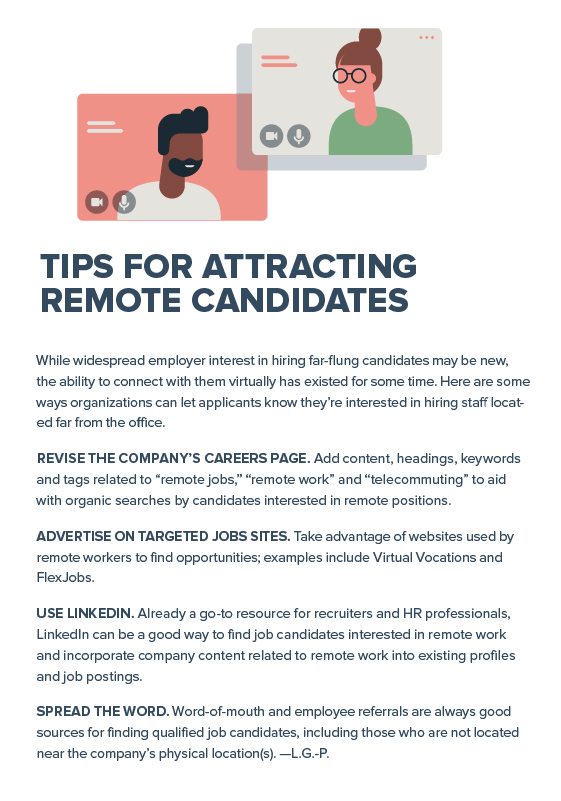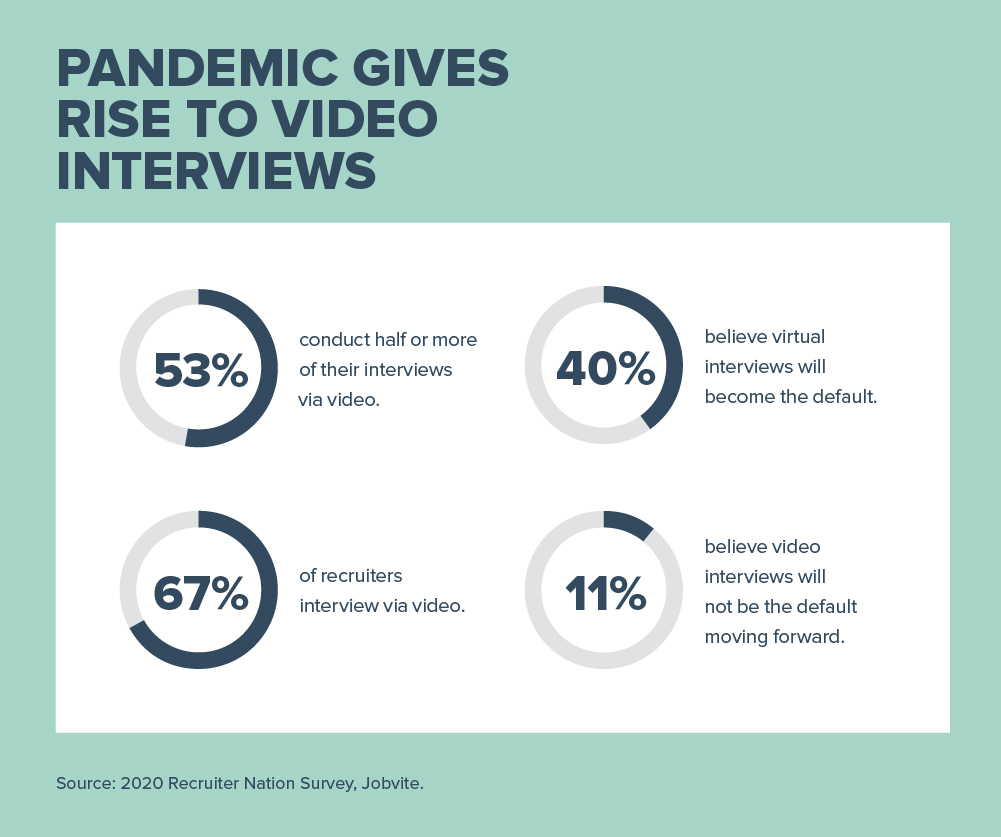COVID-19 Spurs Novel Approaches to Talent Acquisition
The coronavirus crisis has created talent acquisition challenges, but it has also led to larger candidate pools and new ways to connect.
While the global spread of the virus that causes COVID-19 has resulted in enormous damage to the economy and businesses around the world, hiring is still a top priority for many organizations. Talent acquisition just looks a little different now.
Many employers are facing new challenges. Those deemed essential need people onsite to care for patients, serve customers, or make and distribute products. Hiring employees for those roles can be tricky, as some workers are hesitant to be physically present due to concerns about contracting the virus. In other settings, employees can work remotely and are being hired virtually to fill positions without ever visiting the workplace or meeting in person with recruiters, HR reps or hiring managers.
As typically happens in times of turmoil, companies are getting creative. The result is that they’re experimenting with and implementing novel approaches to talent acquisition.
Recruit from Anywhere
Perhaps the most notable change in recruiting over the past year is the expansion of the talent pool. Many organizations today are able to hire people from literally anywhere in the world. That’s a benefit brought about by the tremendous increase in remote work caused by the public health crisis.
“We’re putting a strong emphasis on new recruits being able to work for [us] wherever they are in the country,” says Lucy Newcombe, global head of people and communications at Computershare, a financial services company based in the United Kingdom.
“We believe flexible working is particularly important when the pandemic is making so much in life more complicated or difficult, whether it’s being a parent, getting to the store or attending health appointments,” she explains. “However, we’re clear that this approach will still prove beneficial to both our company and members of our team once life begins to return to normal.”
The situation today offers “a rare window of opportunity for talent acquisition,” says Ken Robinson, market research manager with Motus, a workforce management software company based in Boston. And it’s an opportunity that aligns well with candidates’ desires to work remotely, he notes.
Research from Motus indicates that 40 percent of Generation Z and Millennial professionals want flexibility in choosing where they work. Many of these employees are interested in relocating from high-cost metropolitan areas to more-affordable suburban areas.

For many employees, the desire for remote work hasn’t necessarily been driven by the pandemic. Research from Gallup published in 2017 indicated that 37 percent of workers would switch to a job that allows them to work offsite at least part of the time. Now that so many employees have had a taste of that flexibility, that number is likely to grow.
The trend toward geographic flexibility has also expanded the talent pool for top leadership. “Prior to March 2019, approximately 1 in 10 leadership searches that [we] undertook allowed for the incoming executive to be based outside the home office region,” says Tory Clarke, co-founder and partner at Bridge Partners, an executive search firm in New York City. “Today, that data is flipped—it’s probably only 2 in 10 leadership searches that require a specific location.”
According to Robinson, organizations that are able to “decentralize their offices or adopt remote-work policies are in the best position to benefit from the short-term talent surplus by drawing from the most qualified candidates, regardless of location.”
New Ways to Connect
For many companies, the pandemic has brought to light new ways of connecting with potential hires.
In 2020, Taco Bell hosted safety-conscious hiring parties at hundreds of its locations nationwide. Though the hiring party idea wasn’t new—the company has been holding large-scale job fairs since 2018—the safety and social-distancing protocols were. Interviews took place outdoors, and drive-up interviews allowed applicants to stay in their cars.

Drive-through and virtual career fairs are becoming commonplace. Sometimes they’re organized by employers and sometimes by community groups. The Fairfax County Economic Development Authority, for instance, held a series of virtual career fairs in 2020 to help companies in Northern Virginia connect with job seekers. The first four virtual career fairs attracted nearly 2,600 attendees, according to the organization, and resulted in more than 4,900 conversations between job seekers and hiring representatives from companies such as Microsoft, Amazon Web Services, Capital One and Hewlett Packard Enterprise.
In some cases, candidates might not even interact with people when they interview for a job. Instead, some video interviewing platforms allow applicants to record answers to a uniform set of questions at their convenience, including on evenings and weekends, which lessens the strain on HR and hiring teams. For example, 60 percent of almost 5 million interviews conducted in 2020 using one such app, HireVue, took place outside traditional 9-to-5 business hours, according to a recent New York Timesarticle.
While virtual hiring is not new, many companies have adopted new practices during the pandemic to attract and screen prospective talent. Like many organizations, marketing agency LEWIS uses Zoom to connect with candidates and conduct interviews, says the company’s vice president of HR, Christina Ioannou, who is based in San Francisco. But Ioannou’s team has also started using Loom, a video-messaging tool, to request that candidates send a two-minute introductory video to serve as a sort of elevator pitch.
“It quickly gives us a good impression of the candidate and removes the need for a phone screen,” Ioannou says. “If they present themselves well on this introductory video, we can move them straight to a video interview with the hiring team.”
There are benefits to these types of interactions. “I think the virtual aspect of interviewing has allowed, quite frankly, more time to go through a process and involve more people,” says Harry Osle, global HR advisory practice leader in Miami with The Hackett Group consultancy. Today’s technology, he says—such as Zoom or Microsoft Teams—provides the ability to conduct more-thorough interviews.
In addition, remote interviews save time and money. “In the past, you had to bring people into the office and it was an all-day affair,” he says. “Now you can schedule a multitude of interviews within half a day and nobody is getting on a plane, in a bus or in the car” to come to the interview.
In some cases, companies are requesting presentations instead of conducting standard question-and-answer interviews. “A salesperson can present how they would pitch a product, [or] a CFO could give a presentation on the four or five strategic aspects of the function that [he or she] would change when moving into that role,” Osle says. The format allows candidates to be more creative, he adds.
Even after individuals are hired, they and their co-workers might not be physically located onsite. That makes giving potential candidates and new employees a good sense of the company culture particularly challenging. With many HR professionals working remotely, that task becomes even more difficult.
To address the issue, Virginia-based employer Appian has “established a resource hub giving [its] recruiters the tools and resources they need to easily access employer-branded content to send to candidates,” says Chris Fitzner, a recruitment marketing strategist at the data management company. This content includes microsites, virtual interviewing tips and even a new blog—Appian Life—to highlight employee experiences working in remote settings.
To help drive the creation of content that resonates with incoming candidates, Fitzner suggests focusing on issues new hires may be most interested in. At Appian, a virtual monthly new-hire class available on the company’s social media channels has been popular, he notes.
Fitzner recommends capturing written remarks from employees when crafting the content. “What’s great about written content,” he says, “is that it can stand as a base to create several other assets like social quote cards, podcasts and even video.”
 'During the interview, we emphasize the stability of the company. It’s important to let candidates know Lawson is still hiring during the pandemic.'
'During the interview, we emphasize the stability of the company. It’s important to let candidates know Lawson is still hiring during the pandemic.'
Trista Jones
A Focus on Safety
Even before the pandemic, some employers, such as health care providers, placed a strong emphasis on employee and customer safety. But now, all companies need to consider safety as part of their talent acquisition process. Applicants always have a certain level of anxiety about accepting a job with a new employer. Now those anxieties are often heightened due to concerns about the coronavirus.
XYPRO Technology Corp., a data security company in Simi Valley, Calif., works to allay those worries. “[We are] very transparent with our candidates about flexibility with working from home during COVID and our concern for their safety and well-being,” says Melodie Bond-Hillman, director of HR and administration.
“It’s very important that candidates understand how we have treated employees,” she says. “We have been very active in our blog, on LinkedIn and in trade journals sharing our perspective on how we have been managing through this pandemic while keeping employees engaged and happy working from home. We have many candidates who follow our activity on social media and are aware of our approach to employee satisfaction and engagement. This drives much of our applicant flow.”
Lawson Products, an industrial distributor of maintenance and repair products based in Chicago, also recognizes the importance applicants are placing on safety, says Trista Jones, senior manager of talent acquisition. Her HR team has incorporated a number of safety-related messages and processes into its recruiting strategy. They include holding virtual interviews and disseminating increased communications about what the company is doing to keep employees safe.
To reinforce this messaging, Jones says, the company created new ads to spotlight the safety measures it’s taking and to directly address candidates’ concerns. The company also created a video of its warehouse to provide job seekers with a virtual tour of the facility.
In addition to physical safety, candidates are concerned about the financial stability of the companies they’re interviewing with, Jones says. They want to know if they’ll have a job in a year.
“During the interview, we emphasize the stability of the company,” she says. “It’s important to let candidates know Lawson is still hiring during the pandemic.”
When the pandemic subsides, many employees who are now working remotely will likely return to the office. The Hackett Group’s Osle estimates that just 30 percent of the jobs that are currently remote will remain so. While some predict that percentage will be much higher, he believes that as vaccines are administered and instant testing is developed, the number of offsite workers will drop. In addition, Osle predicts, “a good 40 percent to 50 percent of that talent will be hybrid—some days virtual, some days onsite.”
While no one can say for certain what will occur or when, talent acquisition is unlikely to ever look the same. For many—employers and candidates alike—that could be a very good thing.
Lin Grensing-Pophal is a freelance writer in Chippewa Falls, Wis.


